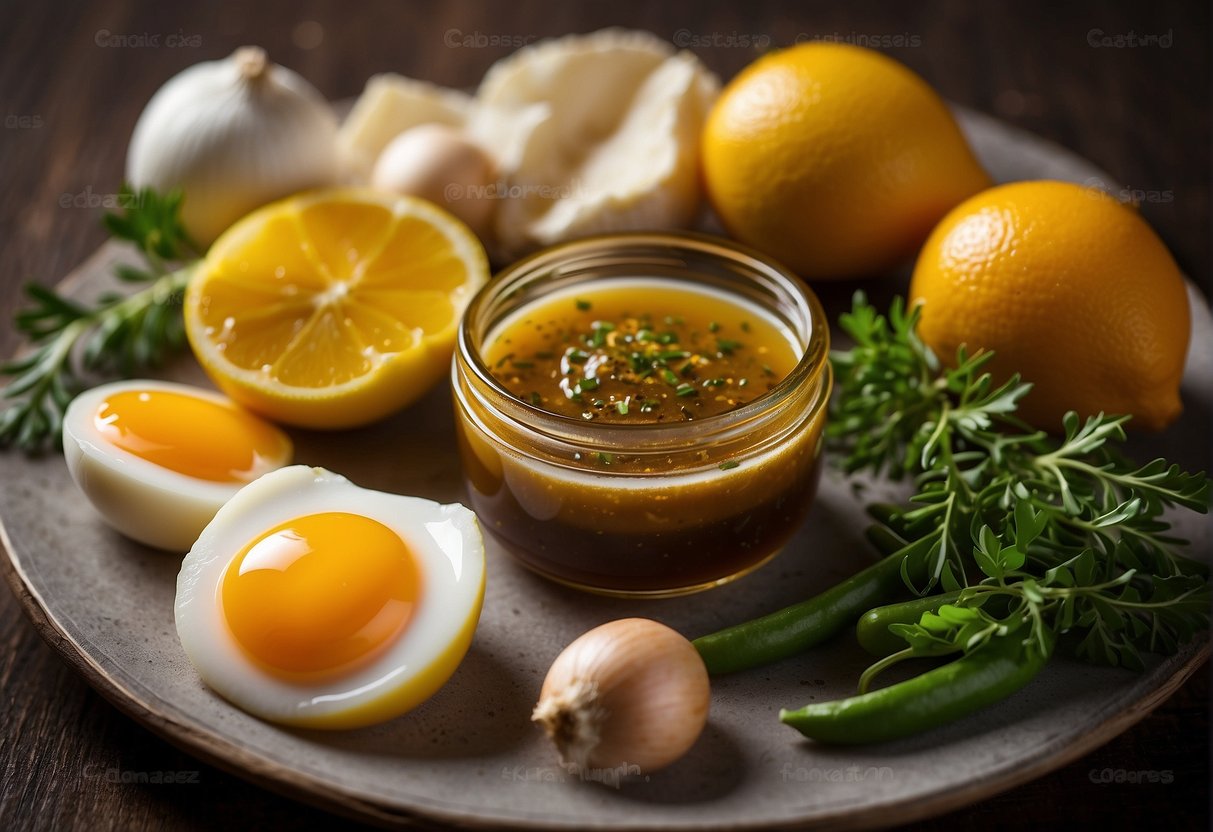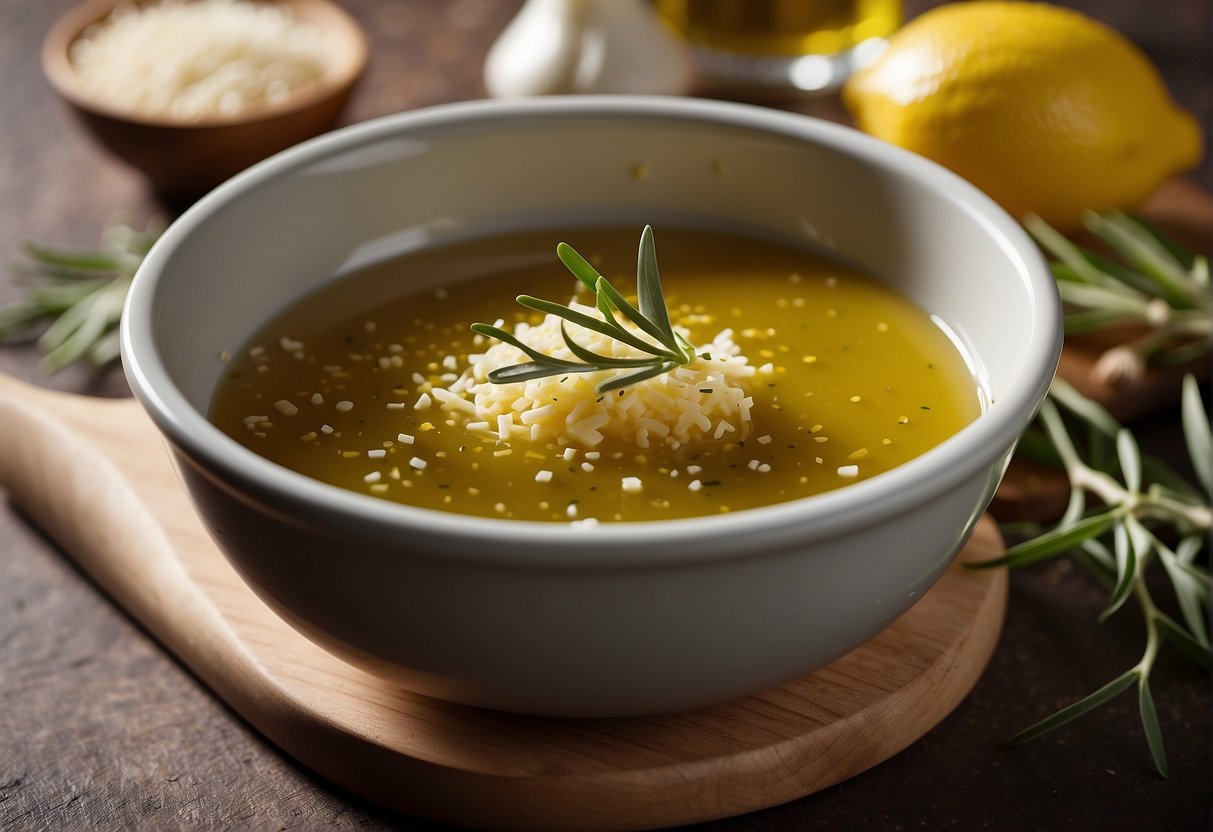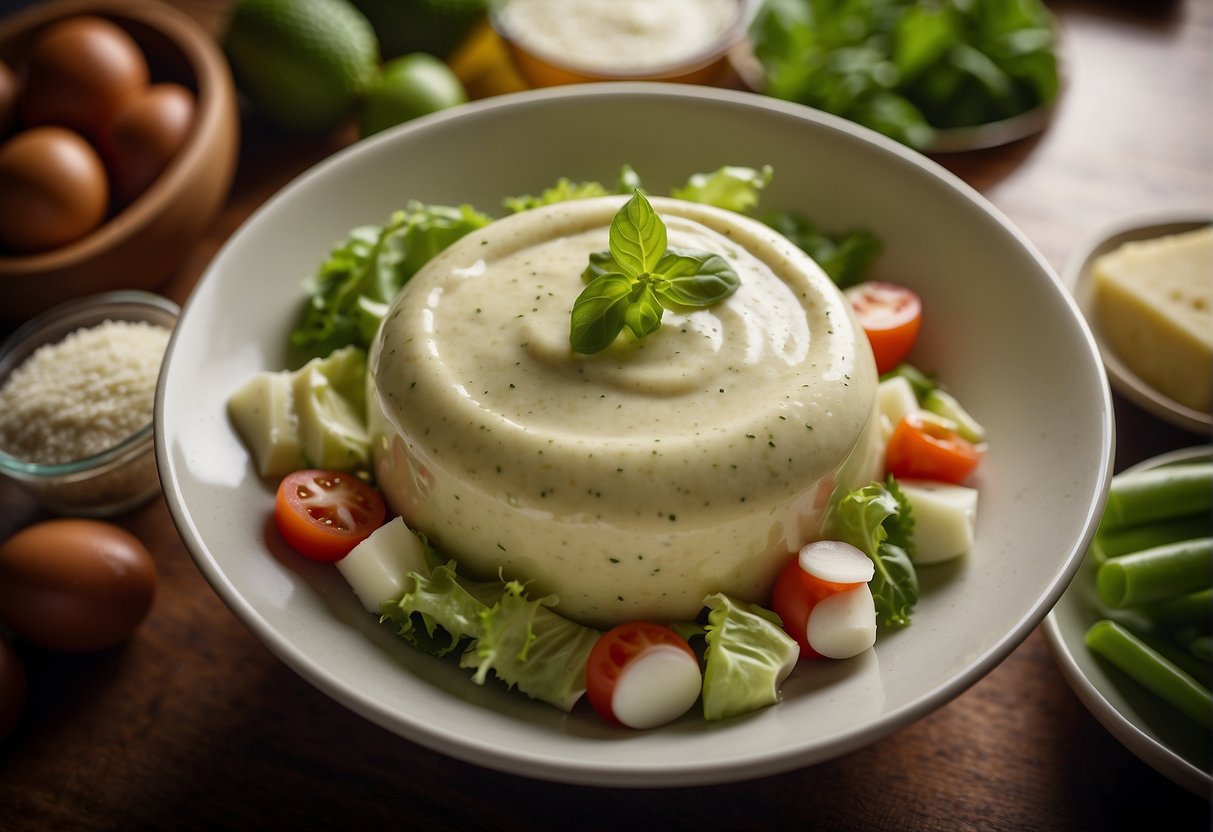Caesar dressing is a staple for any salad enthusiast seeking that creamy, tangy, and delicious addition to their greens. If you’ve ever considered making your own, you’re in luck. In this article, we’re going to explore how to make a classic Caesar dressing recipe that is simple yet packed with flavor.

Creating your own homemade Caesar dressing not only allows you to control the quality of the ingredients, but also gives you the opportunity to customize the taste to your preferences. We’ll guide you step by step so that you can confidently master this dressing in your own kitchen. Whether you’re a die-hard Caesar salad fan or just looking for a versatile dressing to enhance your meals, this recipe is sure to leave you wanting more.
Key Ingredients and Substitutions

Anchovies and Alternatives
Anchovies are a key component in traditional Caesar dressing, providing a distinctive, salty umami flavor. They can be found in the form of anchovy fillets or paste. If you prefer to avoid anchovies, you can substitute with capers or Worcestershire sauce, which contains anchovies but has a milder taste.
Using Fresh vs. Pasteurized Eggs
Classic Caesar dressing often includes raw egg yolks, which add a rich, creamy texture. However, if you’re concerned about using raw eggs, there are a few alternatives:
- Pasteurized eggs: These eggs are heat-treated to kill any potential harmful bacteria, making them safe to consume raw.
- Mayonnaise: Substitute raw egg yolks with a similar amount of mayonnaise, which is made with egg yolk and oil.
- Greek yogurt: For a lighter alternative, use Greek yogurt instead of egg yolks for a creamy texture.
Selecting the Right Cheese
Parmesan, more specifically Parmigiano-Reggiano, is the preferred cheese in Caesar dressing for its sharp and salty flavor. When choosing your parmesan, look for a high-quality, aged cheese. Grate or shave it finely to integrate well into your dressing. If you need a substitution, a good alternative is Pecorino Romano, which has a similarly sharp taste.
Oils and Acidic Components
The choice of oil in your Caesar dressing affects both the taste and consistency. Olive oil is a popular choice and imparts a robust flavor. For a milder taste, you can opt for vegetable oil or a mix of both.
The acidic component of Caesar dressing comes from lemon juice, which provides a fresh, bright flavor. In addition to lemon juice, Dijon mustard is another important acidic ingredient. Its tangy and slightly spicy profile contributes depth, so make sure not to skip it. If desired, a small amount of vinegar, preferably white wine vinegar, can be added to adjust the acidity.
In summary, a well-made Caesar dressing relies on key ingredients such as anchovies (or alternatives), eggs (raw or pasteurized), Parmesan cheese, and a balance of oil and acidity. By selecting the best ingredients and adjusting to your preferences, you can create a delicious dressing that complements any Caesar salad.
Preparation Techniques

Emulsifying the Ingredients
To create a creamy Caesar dressing, you’ll need to properly emulsify the ingredients. This process involves combining oil with water-based elements, such as lemon juice and Worcestershire sauce, which usually don’t mix well. Use a blender, food processor, or immersion blender to ensure all ingredients are incorporated seamlessly. Start by blending garlic, anchovy paste, lemon juice, Dijon mustard, and Worcestershire sauce. Then, gradually add in oil while the machine is running to achieve the desired emulsion.
Adjusting Consistency and Flavor
Once the primary ingredients are well-emulsified, it’s time to adjust the consistency and flavor to your preference. To thicken the dressing and add a rich, cheesy taste, incorporate mayonnaise and grated Parmigiano-Reggiano cheese. Don’t be afraid to taste-test the dressing during this process, making necessary adjustments to achieve the perfect balance. You might need to add more salt, pepper, or additional ingredients to suit your taste buds.
Here is a simple guideline for adjusting the flavor:
- Thicker consistency: Add more mayonnaise or grated cheese
- Tangier taste: Increase the lemon juice
- Salty punch: Use more anchovy paste
Safety Measures with Raw Eggs
Caesar dressing traditionally contains raw egg or raw egg yolks, which aid in emulsifying the sauce and providing a luxurious texture. However, consuming raw eggs may pose a risk of foodborne illness. To minimize this risk, opt for pasteurized eggs as they have been heated briefly to kill off any harmful bacteria without impacting the egg’s texture or flavor. Remember to store the dressing in the refrigerator and consume within a week for optimal freshness and safety.
Classic vs. Modern Variations
The Role of Umami Flavor
When you think of Caesar salad dressing, one of the key components is its umami flavor. In the original version of the dressing, the umami flavor primarily came from Worcestershire sauce. As the recipe evolved, a more pronounced umami taste was achieved by introducing ingredients like anchovies and Dijon mustard into the mix.
Classic:
- Umami from Worcestershire sauce
Modern:
- Enhanced umami from anchovies
- Flavor boost from Dijon mustard
Healthier Alternatives
Though Caesar salad dressing is undeniably delicious, it can be high in calories and unhealthy fats due to the traditional ingredients like raw egg yolks and oil. Fortunately, there are healthier alternatives that maintain the beloved tangy flavor while cutting back on calories.
Healthier options:
- Swap raw egg yolks for Greek yogurt or tofu
- Opt for low-fat mayonnaise
- Choose grapeseed or olive oil instead of vegetable oil
Catering to Dietary Restrictions
The classic Caesar salad dressing recipe might not be suitable for everyone, especially those following vegan diets. However, you can easily create a delicious homemade Caesar dressing that caters to different dietary restrictions without sacrificing taste.
Vegan-friendly substitutions:
- Use mashed avocado or dairy-free yogurt as a base
- Replace anchovies with capers or miso paste
- Choose nutritional yeast or vegan cheese as a Parmesan substitute
In conclusion, whether you prefer the classic Caesar salad dressing or its modern variations, there are plenty of options to suit your taste preferences and dietary needs. All it takes is a quick modification to the ingredients, and you can enjoy a delicious, tangy, umami-flavored Caesar dressing in no time.
Serving and Pairings
Beyond Caesar Salad
Although Caesar dressing is commonly paired with romaine lettuce and croutons to create the classic Caesar salad, there are numerous other dishes that can benefit from its savory flavor. For a more filling option, consider adding grilled chicken to your Caesar salad to create a chicken Caesar salad. This dish makes for a delicious entrée on its own or a satisfying side dish when paired with a main course.
Moreover, Caesar dressing can be used as a dipping sauce for various appetizers, such as raw vegetables, breadsticks, or even fried calamari. You can also drizzle it over roasted or grilled vegetables to enhance their flavors.
Proper Storage Tips
To maintain freshness and prevent spoilage, it’s important to properly store your homemade Caesar dressing. Transfer the dressing to an airtight container and refrigerate. When stored correctly, the dressing should last for up to 1 week in the fridge. It’s crucial to keep it chilled, as the ingredients are perishable and can spoil quickly if left at room temperature.
Remember, whenever you’re ready to use your dressing, always give it a good stir or shake to recombine any separated ingredients. This ensures that you get a consistent and flavorful dressing to enhance your dishes.
By experimenting with various uses and taking care to properly store your homemade Caesar dressing, you can maximize its potential and add an extra layer of flavor to your meals.
Making Caesar Dressing at Home
Creating a homemade Caesar dressing is not only simple but also allows you to control the quality of ingredients and adjust the taste to your preference. This versatile dressing can be used as a classic vinaigrette for salads, a marinade for meats, or even as a dip.
Step-by-Step Recipe
To make your own homemade Caesar salad dressing, follow these steps:
-
Ingredients:
- 1 garlic clove
- 1 tsp anchovy paste or 2 anchovies
- 2 tsp lemon juice
- 1 tsp Dijon mustard
- 1 tsp Worcestershire sauce
- ½ cup mayonnaise
- ¼ cup grated Parmigiano-Reggiano cheese
- Salt and pepper, to taste
-
Preparation:
- Mince the garlic clove or press it using a garlic press.
- If using anchovies, finely chop them.
-
Mixing:
- In a mixing bowl, whisk together the garlic, anchovy paste (or chopped anchovies), lemon juice, Dijon mustard, and Worcestershire sauce.
- Gradually whisk in the mayonnaise until the mixture is smooth and creamy.
- Stir in the grated Parmigiano-Reggiano cheese and season with salt and pepper to taste.
-
Storage:
- Store the dressing in a sealed container in the refrigerator for up to a week.
Troubleshooting Common Issues
Here are some common issues you might encounter when making Caesar dressing and how to fix them:
- Dressing is too thin: If the dressing is too runny, you can thicken it by adding more grated Parmigiano-Reggiano cheese or mayonnaise. Whisk well to incorporate the added ingredients.
- Dressing is too thick: To thin out a thick dressing, gradually add a small amount of water or lemon juice while whisking. Add a teaspoon at a time until you reach your desired consistency.
- Dressing is too salty: If the dressing is overly salty, try adding more lemon juice or a pinch of sugar to balance the flavors.
Exploring the History of Caesar Dressing
The story of Caesar dressing begins with its creator, Italian-American chef Caesar Cardini. In the 1920s, Cardini invented this salad dressing at his restaurant in Tijuana, Mexico, while catering to American tourists during Prohibition. Although the dressing is named after him, its roots are deeply intertwined with American cuisine.
There are a few key ingredients that make up authentic Caesar dressing. They include:
- Anchovies or anchovy paste: Adds a distinct umami flavor that is essential to the dressing.
- Egg yolks: Creates a rich and creamy base.
- Garlic: Brings an aromatic and slightly pungent note.
- Lemon juice: Offers that tangy, citrus element that balances the richness.
- Dijon mustard: Adds a bit of sharpness and helps emulsify the dressing.
- Olive oil: Contributes to the dressing’s silky texture.
- Parmesan cheese: Adds a savory and slightly nutty taste.
Caesar dressing falls into the category of salad dressings specifically designed for Caesar salad but also pairs well with various other salads and dishes. Whisking or blending these ingredients together creates a unique, delicious, and versatile dressing.
Over time, variations of Caesar dressing have emerged. Some recipes exclude anchovies for a milder taste, while others opt for replacing egg yolks with mayonnaise for a more convenient option. Nonetheless, the traditional and authentic version remains a favorite among many. As a signature part of American cuisine, Caesar dressing has undeniably left its mark on culinary history.
Embrace the rich history of Caesar dressing by trying your hand at making your own authentic version at home. Delight in the creamy and tangy blend of flavors and understand why this classic recipe has remained popular throughout the years.